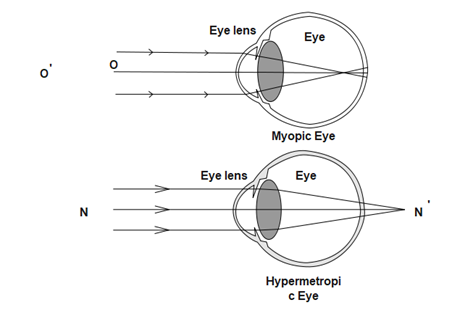
My grandfather uses a bifocal lens in his spectacle. Explain why?
Answer
481.5k+ views
Hint: Grandfather suffers from hypermetropia as well as myopia. Myopia is a common refractive mistake, or short-sightedness, that can occur in both adults and children. In those under the age of forty, it is most common, typically beginning during childhood. The term used to define being long sighted is hypermetropia, sometimes called hyperopia.
Complete step by step solution:

1.When looking at objects close to them a myopic individual has clear vision, but distant objects will appear blurred.
2.This is because light is concentrated in front of the retina and being too far forward in the eye, things look blurred in the distance and the image of a nearby object is created behind the retina if you are hypermetropia.
3.This implies that light is focused too far back into the eye causing blurred things that are close up to appear.
4.The lodging power of the eye usually decreases with ageing. The near point gradually recedes away for most individuals. They find it difficult without corrective eye-glasses to see nearby objects comfortably and distinctly.
5.It occurs due to the gradual weakening of the ciliary muscles and decreasing eye lens flexibility.
6. This defect is called Presbyopia. Near and distance vision is impaired in a few elderly people. The upper part of the bifocal lens is a concave lens for correcting myopia and the lower part is a convex lens for close vision. Therefore, in his show, grandpa uses a bifocal lens.
Note:
The optometrist at your local Vision Express can easily correct both myopia and hypermetropia, using prescription glasses or contact lenses specifically designed to counteract their effects. Using a concave (curved inward) lens that is placed in front of a myopic eye, shifting the image back to the retina and making it clearer, shortsightedness is corrected. Using a convex (outward facing) lens, long-sightedness is corrected. This is positioned in front of a hypermetropia eye, moving the picture forward and correctly focusing it on the retina.
Complete step by step solution:

1.When looking at objects close to them a myopic individual has clear vision, but distant objects will appear blurred.
2.This is because light is concentrated in front of the retina and being too far forward in the eye, things look blurred in the distance and the image of a nearby object is created behind the retina if you are hypermetropia.
3.This implies that light is focused too far back into the eye causing blurred things that are close up to appear.
4.The lodging power of the eye usually decreases with ageing. The near point gradually recedes away for most individuals. They find it difficult without corrective eye-glasses to see nearby objects comfortably and distinctly.
5.It occurs due to the gradual weakening of the ciliary muscles and decreasing eye lens flexibility.
6. This defect is called Presbyopia. Near and distance vision is impaired in a few elderly people. The upper part of the bifocal lens is a concave lens for correcting myopia and the lower part is a convex lens for close vision. Therefore, in his show, grandpa uses a bifocal lens.
Note:
The optometrist at your local Vision Express can easily correct both myopia and hypermetropia, using prescription glasses or contact lenses specifically designed to counteract their effects. Using a concave (curved inward) lens that is placed in front of a myopic eye, shifting the image back to the retina and making it clearer, shortsightedness is corrected. Using a convex (outward facing) lens, long-sightedness is corrected. This is positioned in front of a hypermetropia eye, moving the picture forward and correctly focusing it on the retina.
Recently Updated Pages
Master Class 12 Business Studies: Engaging Questions & Answers for Success

Master Class 12 English: Engaging Questions & Answers for Success

Master Class 12 Social Science: Engaging Questions & Answers for Success

Master Class 12 Chemistry: Engaging Questions & Answers for Success

Class 12 Question and Answer - Your Ultimate Solutions Guide

Master Class 11 Economics: Engaging Questions & Answers for Success

Trending doubts
Which one of the following is a true fish A Jellyfish class 12 biology CBSE

Draw a labelled sketch of the human eye class 12 physics CBSE

a Tabulate the differences in the characteristics of class 12 chemistry CBSE

Why is the cell called the structural and functional class 12 biology CBSE

Differentiate between homogeneous and heterogeneous class 12 chemistry CBSE

What are the major means of transport Explain each class 12 social science CBSE




